Study on Polymer Electrolyte Fuel Cells with Nonhumidification Using Metal Foam in Dead-Ended Operation
Abstract
1. Introduction
2. Experiments
2.1. Experimental Setup
2.2. Experimental Conditions
3. Results and Discussion
3.1. Suitability for Nonhumidified Operation
3.2. Effect of Metal Foam on the Optimized System for Portable Power
4. Conclusions
Author Contributions
Funding
Conflicts of Interest
References
- Heinzel, A.; Hebling, C.; Müller, M.; Zedda, M.; Müller, C. Fuel cells for low power applications. J. Power Sources 2002, 105, 250–255. [Google Scholar] [CrossRef]
- Meyers, J.P.; Maynard, H.L. Design considerations for miniaturized PEM fuel cells. J. Power Sources 2002, 109, 76–88. [Google Scholar] [CrossRef]
- Chang, H.; Kim, J.R.; Cho, J.H.; Kim, H.K.; Choi, K.H. Materials and processes for small fuel cells. Solid State Ion. 2002, 148, 601–606. [Google Scholar] [CrossRef]
- Wang, Y.; Chen, K.S.; Mishler, J.; Cho, S.C.; Adroher, X.C. A review of polymer electrolyte membrane fuel cells: Technology, applications, and needs on fundamental research. Appl. Energy 2011, 88, 981–1007. [Google Scholar] [CrossRef]
- Giddey, S.; Badwal, S.P.S.; Ciacchi, F.T.; Fini, D.; Sexton, B.A.; Glenn, F.; Leech, P.W. Investigations on fabrication and lifetime performance of self – air breathing direct hydrogen micro fuel cells. Int. J. Hydrogen Energy 2010, 35, 2506–2516. [Google Scholar] [CrossRef]
- Achmad, F.; Kamarudin, S.K.; Daud, W.R.W.; Majlan, E.H. Passive direct methanol fuel cells for portable electronic devices. Appl. Energy 2011, 88, 1681–1689. [Google Scholar] [CrossRef]
- Wilberforce, T.; Alaswad, A.; Palumbo, A.; Dassisti, M.; Olabi, A.G. Advances in stationary and portable fuel cell applications. Int. J. Hydrogen Energy 2016, 41, 16509–16522. [Google Scholar] [CrossRef]
- Hsu, F.K.; Lee, M.S.; Lin, C.C.; Lin, Y.K.; Hsu, W.T. A flexible portable proton exchange membrane fuel cell. J. Power Sources 2012, 219, 180–187. [Google Scholar] [CrossRef]
- Oszcipok, M.; Zedda, M.; Hesselmann, J.; Huppmann, M.; Wodrich, M.; Junghardt, M.; Hebling, C. Portable proton exchange membrane fuel-cell systems for outdoor applications. J. Power Sources 2006, 157, 666–673. [Google Scholar] [CrossRef]
- Kundu, P.P.; Dutta, K. 6-Hydrogen Fuel Cells for Portable Applications. In Woodhead Publishing Series in Energy, Compendium of Hydrogen Energy; Michael, B., Angelo, B., Nejat Veziroğlu, T., Eds.; Woodhead Publishing: Cambridge, UK, 2016. [Google Scholar]
- Cacciola, G.; Antonucci, V.; Freni, S. Technology up date and new strategies on fuel cells. J. Power Sources 2001, 100, 67–79. [Google Scholar] [CrossRef]
- Voss, H.; Huff, J. Portable fuel cell power generator. J. Power Sources 1997, 65, 155–158. [Google Scholar] [CrossRef]
- Yang, C.N.; Kim, Y.D. Development and Demonstration of 150W Fuel Cell Propulsion System for Unmanned Aerial Vehicle (UAV). Trans. Korean Hydrog. New Energy Soc. 2012, 23, 300–309. [Google Scholar] [CrossRef]
- Inman, K.; Ahmad, Z.; Shi, Z.; Wang, X. Design of a proton exchange membrane portable fuel cell system for the 1st international association for hydrogen energy design competition. Int. J. Hydrogen Energy 2011, 36, 13868–13874. [Google Scholar] [CrossRef]
- Hikita, S.; Nakamani, F.; Yamane, K.; Takagi, Y. Power-generation characteristics of hydrogen fuel cell with dead-end system. JSAE Rev. 2002, 23, 177–182. [Google Scholar] [CrossRef]
- Wang, J.; Xiao, D. Development and Evaluation of a Portable Fuel Cell Hybrid System; Chinese Automation Congress (CAC): Xi’an, China, 2018. [Google Scholar]
- Hwang, J.-J. Effect of hydrogen delivery schemes on fuel cell efficiency. J. Power Sources 2013, 239, 54–63. [Google Scholar] [CrossRef]
- Himanen, O.; Hottinen, T.; Tuurala, S. Operation of a planar free-breathing PEMFC in a dead-end mode. Electrochem. Commun. 2007, 9, 891–894. [Google Scholar] [CrossRef]
- Dumercy, L.; Pera, M.C.; Glises, R.; Hissel, D.; Hamandi, S.; Badin, F. PEFC stack operating in anodic dead end mode. Fuel Cells 2004, 4, 352–357. [Google Scholar] [CrossRef]
- Li, H.; Tang, Y.; Wang, Z.; Shi, Z.; Wu, S.; Song, D.; Zhang, J.; Fatih, K.; Zhang, J.; Wang, H.; et al. A review of water flooding issues in the proton exchange membrane fuel cell. J. Power Sources 2008, 178, 103–117. [Google Scholar] [CrossRef]
- Lee, Y.; Kim, B.; Kim, Y. An experimental study on water transport through the membrane of a PEFC operating in the dead-end mode. Int. J. Hydrogen Energy 2009, 34, 7768–7779. [Google Scholar] [CrossRef]
- Siegel, J.B.; McKay, D.A.; Stefanopoulou, A.G.; Hussey, D.S.; Jacobson, D.L. Measurement of liquid water accumulation in a PEMFC with dead-ended anode. J. Electrochem. Soc. 2008, 155, 1168–1178. [Google Scholar] [CrossRef]
- Sasmito, A.P.; Ali, M.I.; Shamim, T. A factorial study to investigate the purging effect on the performance of a dead-end anode PEM fuel cell stack. Fuel Cells 2015, 15, 160–169. [Google Scholar] [CrossRef]
- Yang, C.W.; Chen, Y.S. A mathematical model to study the performance of a proton exchange membrane fuel cell in a dead-ended anode mode. Appl. Energy 2014, 130, 113–121. [Google Scholar] [CrossRef]
- Gomez, A.; Raj, A.; Sasmito, A.P.; Shamim, T. Effect of operating parameters on the transient performance of a polymer electrolyte membrane fuel cell stack with a dead-end anode. Appl. Energy 2014, 130, 692–701. [Google Scholar] [CrossRef]
- Yang, Y.; Zhang, X.; Guo, L.; Liu, H. Overall and local effects of operating conditions in PEM fuel cells with dead-ended anode. Int. J. Hydrogen Energy 2017, 42, 4690–4698. [Google Scholar] [CrossRef]
- Chen, Y.S.; Yang, C.W.; Lee, J.Y. Implementation and evaluation for anode purging of a fuel cell based on nitrogen concentration. Appl. Energy 2014, 113, 1519–1524. [Google Scholar] [CrossRef]
- Nikiforow, K.; Karimaki, H.; Keranen, T.M.; Ihonen, J. Optimization study of purge cycle in proton exchange membrane fuel cell system. J. Power Sources 2013, 238, 336–344. [Google Scholar] [CrossRef]
- Lin, Y.F.; Chen, Y.S. Experimental study on the optimal purge duration of a proton exchange membrane fuel cell with a dead-ended anode. J. Power Sources 2017, 340, 176–182. [Google Scholar] [CrossRef]
- Gomez, A.G.; Sasmito, A.P.; Shamim, T. Investigation of the purging effect on the performance of dead-end anode PEM fuel cell vehicle: A driving cycle test. ECS Trans. 2013, 58, 229–242. [Google Scholar] [CrossRef]
- Yang, Y.; Zhang, X.; Guo, L.; Liu, H. Different flow fields, operation modes and designs for proton exchange membrane fuel cells with dead-ended anode. Int. J. Hydrogen Energy 2018, 43, 1769–1780. [Google Scholar] [CrossRef]
- Carton, J.G.; Olabi, A.G. Three-dimensional proton exchange membrane fuel cell model: Comparison of double channel and open pore cellular foam flow plates. Energy 2017, 136, 185–195. [Google Scholar] [CrossRef]
- Carton, J.G.; Olabi, A.G. Representative model and flow characteristics of open pore cellular foam and potential use in proton exchange membrane fuel cells. Int. J. Hydrogen Energy 2015, 40, 5726–5738. [Google Scholar] [CrossRef]
- Chen, R.; Zhao, T.S. Porous current collectors for passive direct methanol fuel cells. Electrochim. Acta 2007, 52, 4317–4324. [Google Scholar] [CrossRef]
- Bao, Z.; Niu, Z.; Jiao, K. Numerical simulation for metal foam two-phase flow field of proton exchange membrane fuel cell. Int. J. Hydrogen Energy 2019, 44, 6229–6244. [Google Scholar] [CrossRef]
- Huo, S. Experimental investigation on PEM fuel cell cold start behavior containing porous metal foam as cathode flow distributor. Appl. Energy 2017, 203, 101–114. [Google Scholar] [CrossRef]
- Tseng, C.-J. A PEM fuel cell with metal foam as flow distributor. Energy Convers. Manag. 2012, 62, 14–21. [Google Scholar] [CrossRef]
- Tsai, B.-T. Effects of flow field design on the performance of a PEM fuel cell with metal foam as the flow distributor. Int. J. Hydrogen Energy 2012, 37, 13060–13066. [Google Scholar] [CrossRef]
- Kumar, A.; Reddy, R.G. Modeling of polymer electrolyte membrane fuel cell with metal foam in the flow-field of the bipolar/end plates. J. Power Sources 2003, 114, 54–62. [Google Scholar] [CrossRef]
- Kumar, A.R. Materials and design development for bipolar/end plates in fuel cells. J. Power Sources 2004, 29, 62–67. [Google Scholar] [CrossRef]
- Tabe, Y. Performance characteristics and internal phenomena of polymer electrolyte membrane fuel cell with porous flow field. J. Power Sources 2013, 238, 21–28. [Google Scholar] [CrossRef]
- Wang, Y. Porous-media flow fields for polymer electrolyte fuel cells I. Low humidity operation. J. Electrochem. Soc. 2009, 156, B1124–B1133. [Google Scholar] [CrossRef]
- Wang, Y. Porous-media flow fields for polymer electrolyte fuel cells II. Analysis of channel two-phase flow. J. Electrochem. Soc. 2009, 156, B1134–B1141. [Google Scholar] [CrossRef]
- Afshari, E.; Houreh, N.B. Performance analysis of a membrane humidifier containing porous metal foam as flow distributor in a PEM fuel cell system. Energy Convers. Manag. 2014, 88, 612–621. [Google Scholar] [CrossRef]
- Yoon, Y.; Jo, Y.; Kim, H.S. Experimental investigation of liquid water droplet removal in a simulated polymer electrolyte membrane fuel cell gas channel with gas diffusion layer characteristics. J. Mech. Sci. Technol. 2014, 28, 5221–5230. [Google Scholar] [CrossRef]
- Adroher, X.C.; Wang, Y. Ex situ and modeling study of two-phase flow in a single channel of polymer electrolyte membrane fuel cells. J. Power Sources 2011, 196, 9544–9551. [Google Scholar] [CrossRef]
- Kim, M.; Kim, C.; Sohn, Y. Application of Metal Foam as a Flow Field for PEM Fuel Cell Stack. Fuel Cells 2019, 18, 123–128. [Google Scholar] [CrossRef]
- Kim, M.; Kim, C.; Sohn, Y. A Study on Performance of Polymer Electrolyte Membrane Fuel Cell Using Metal Foam. Trans. Korean Hydrog. New Energy Soc. 2015, 26, 554–559. [Google Scholar] [CrossRef]
- Dicks, A.L.; David, A.; Rand, J. Fuel Cell Systems Explained, 3rd ed.; John Wiley & Sons Ltd: Hoboken, NJ, USA, 2018. [Google Scholar]
- O’hayre, R.; Cha, S.W.; Colella, W.; Prinz, F.B. Fuel Cell Fundamentals, 3rd ed.; John Wiley & Sons: Hoboken, NJ, USA, 2016. [Google Scholar]
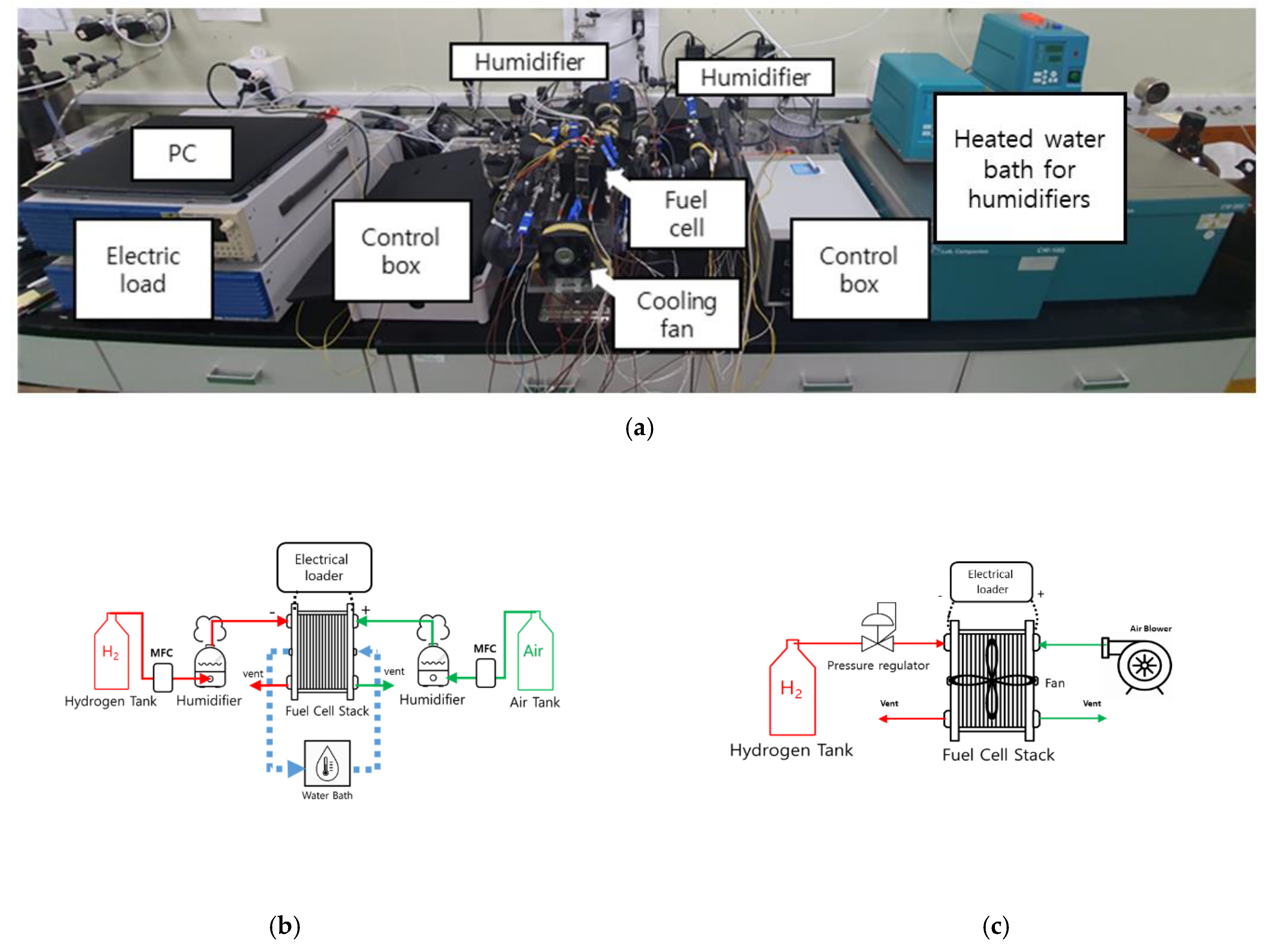
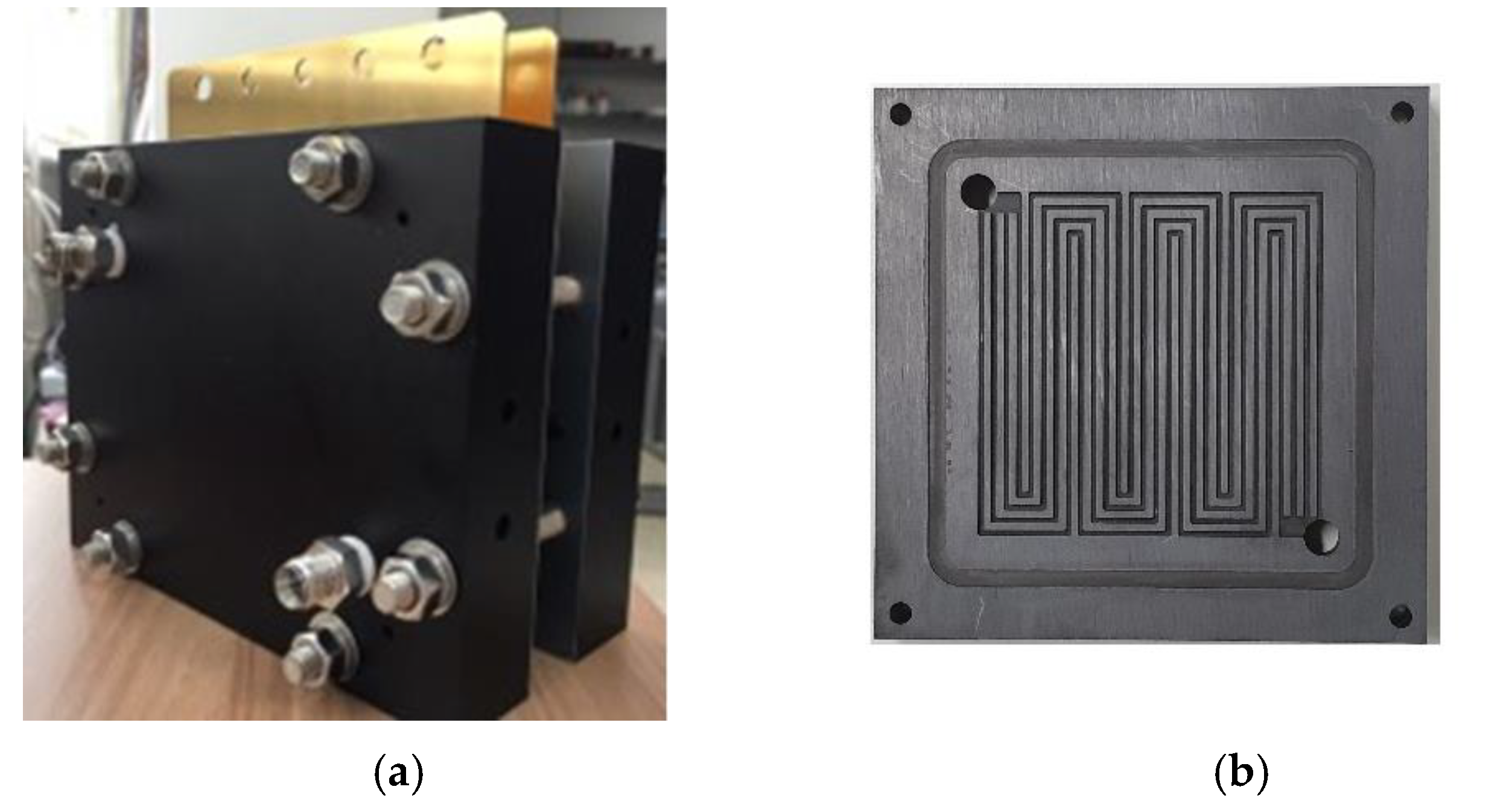
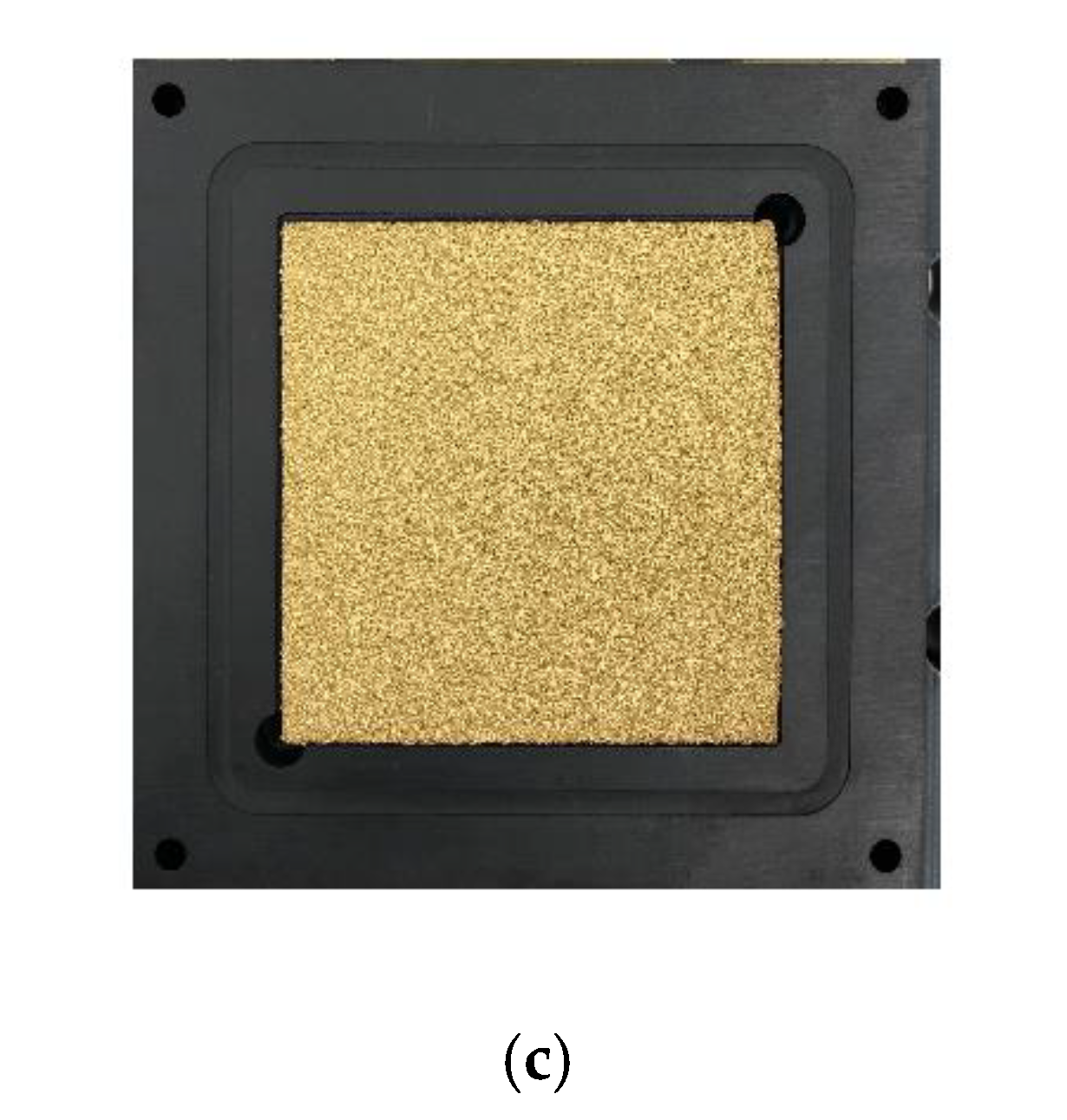
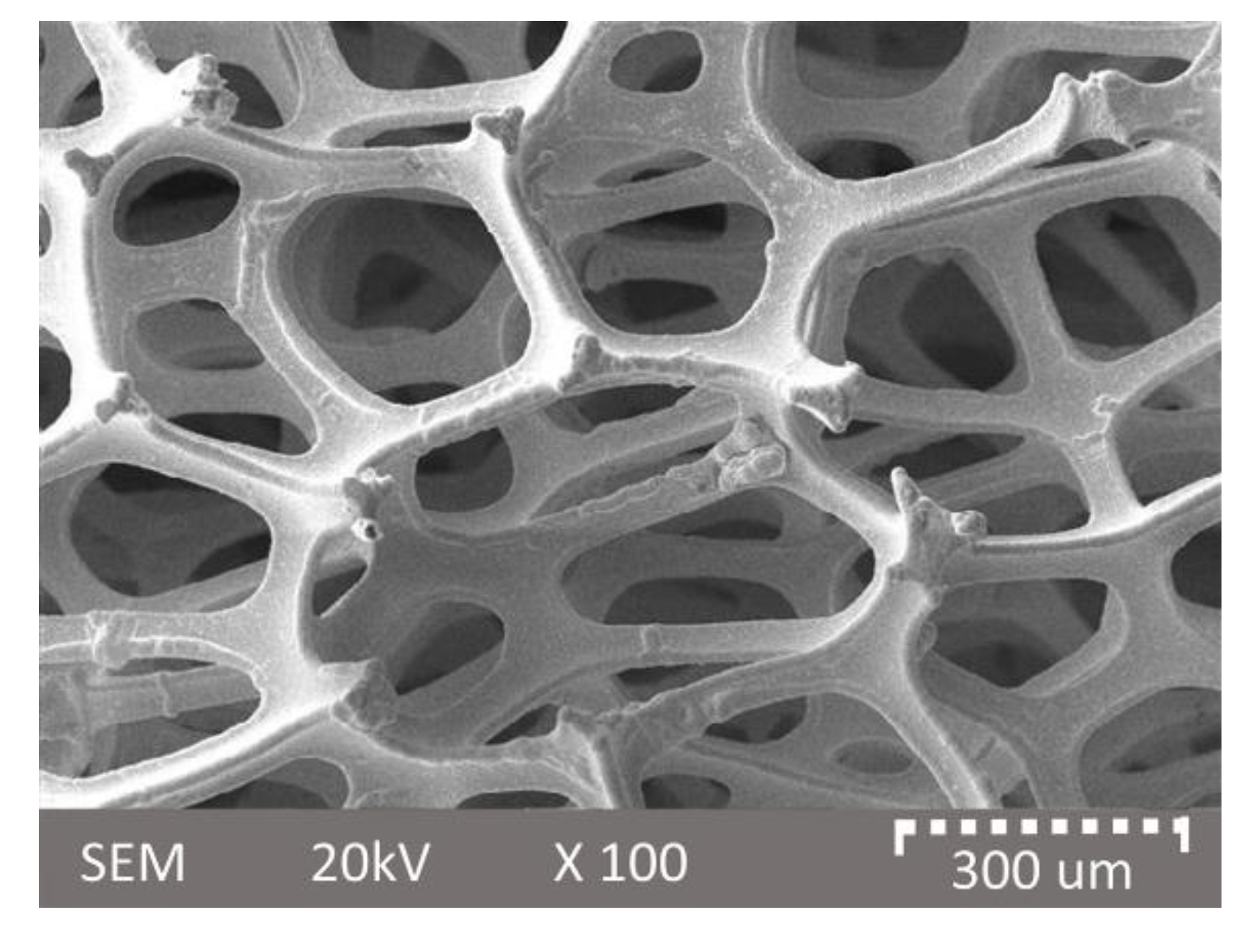
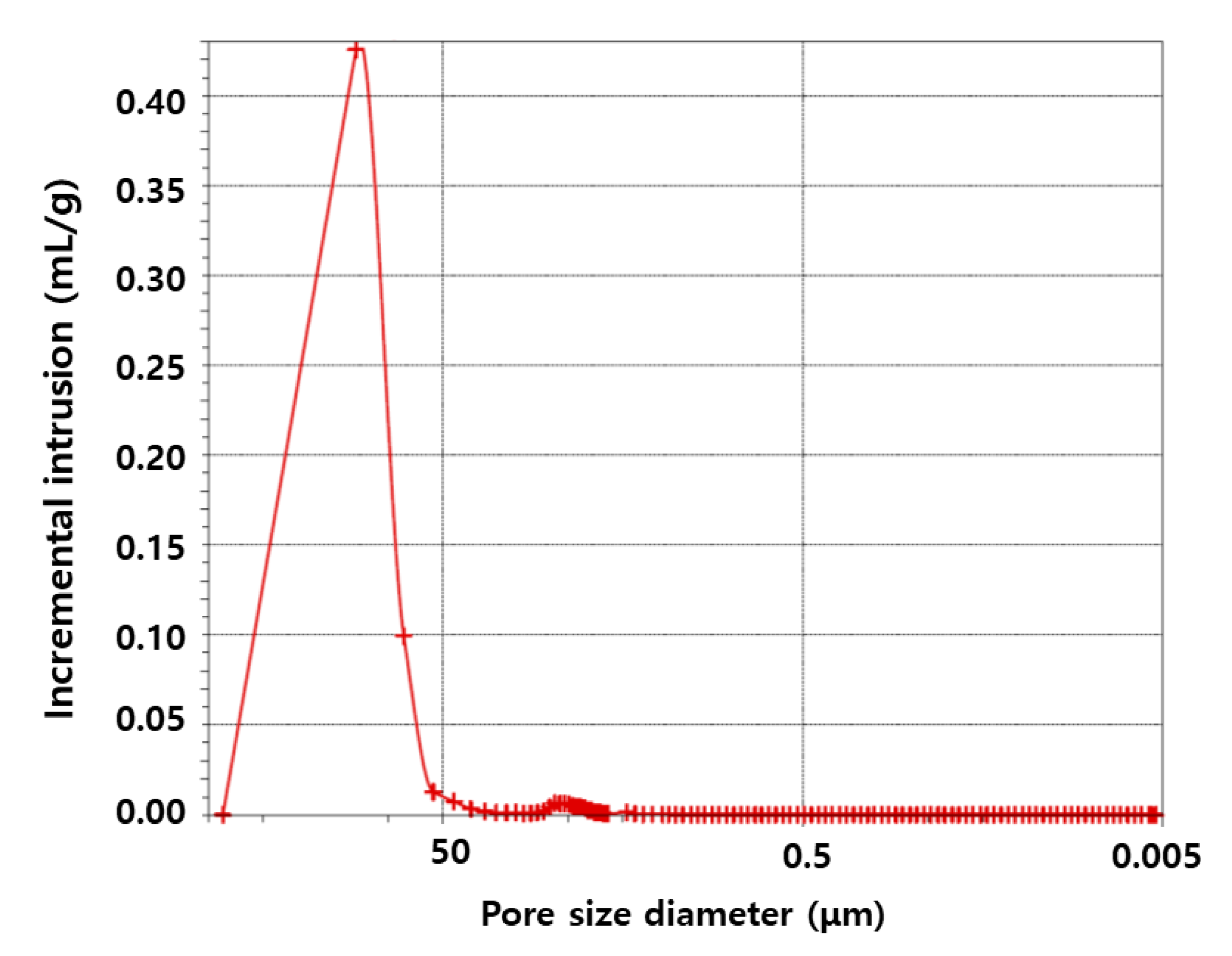
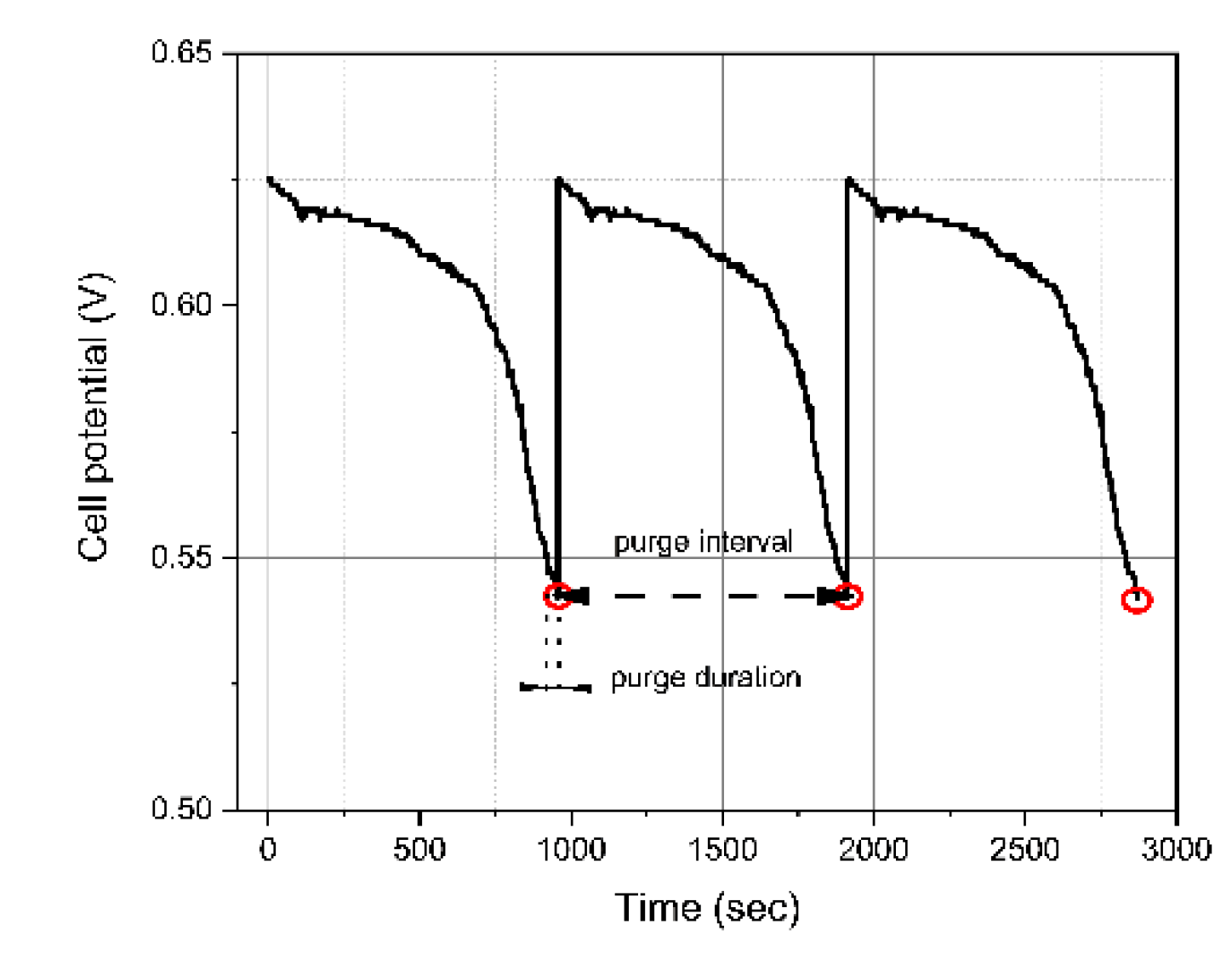
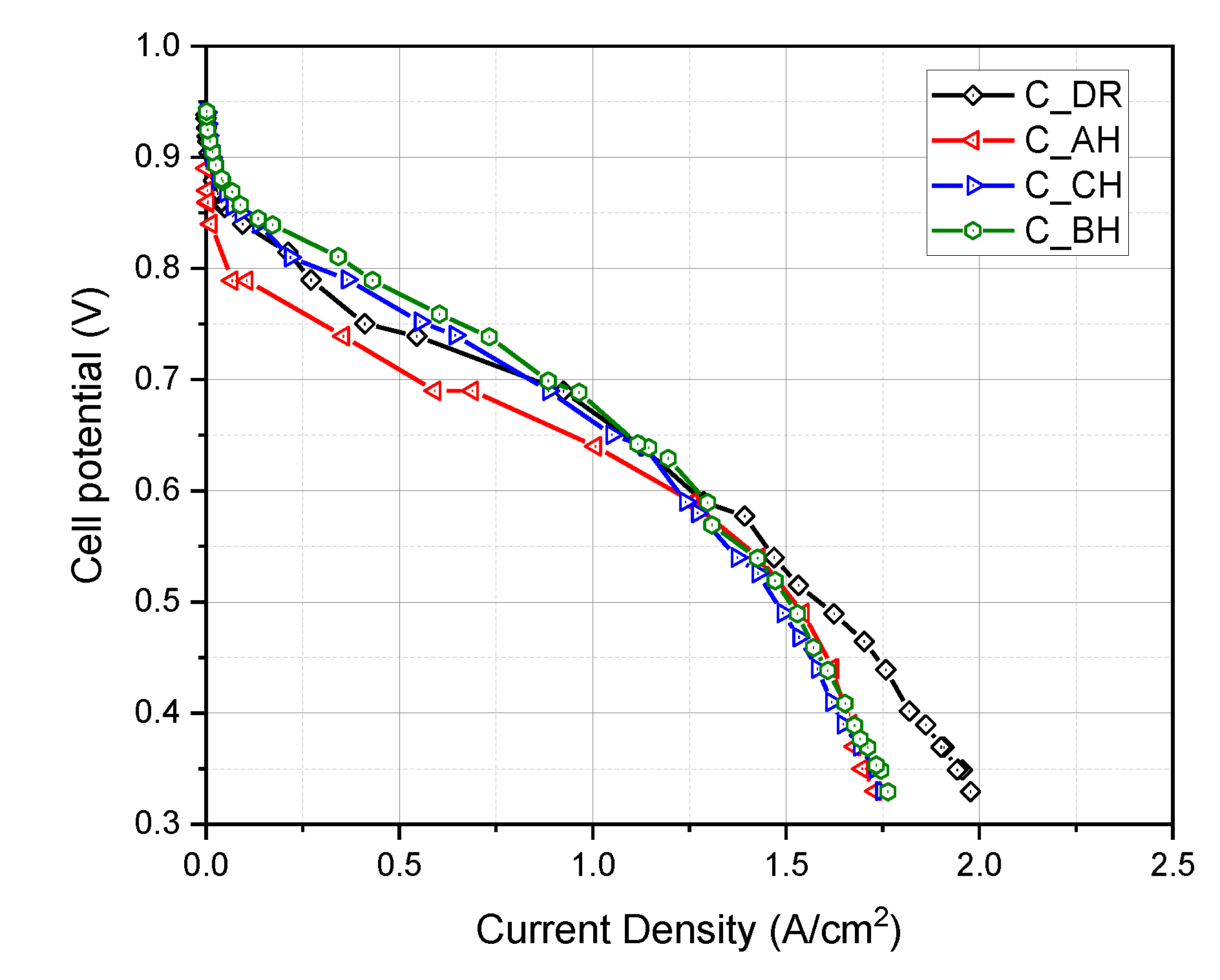
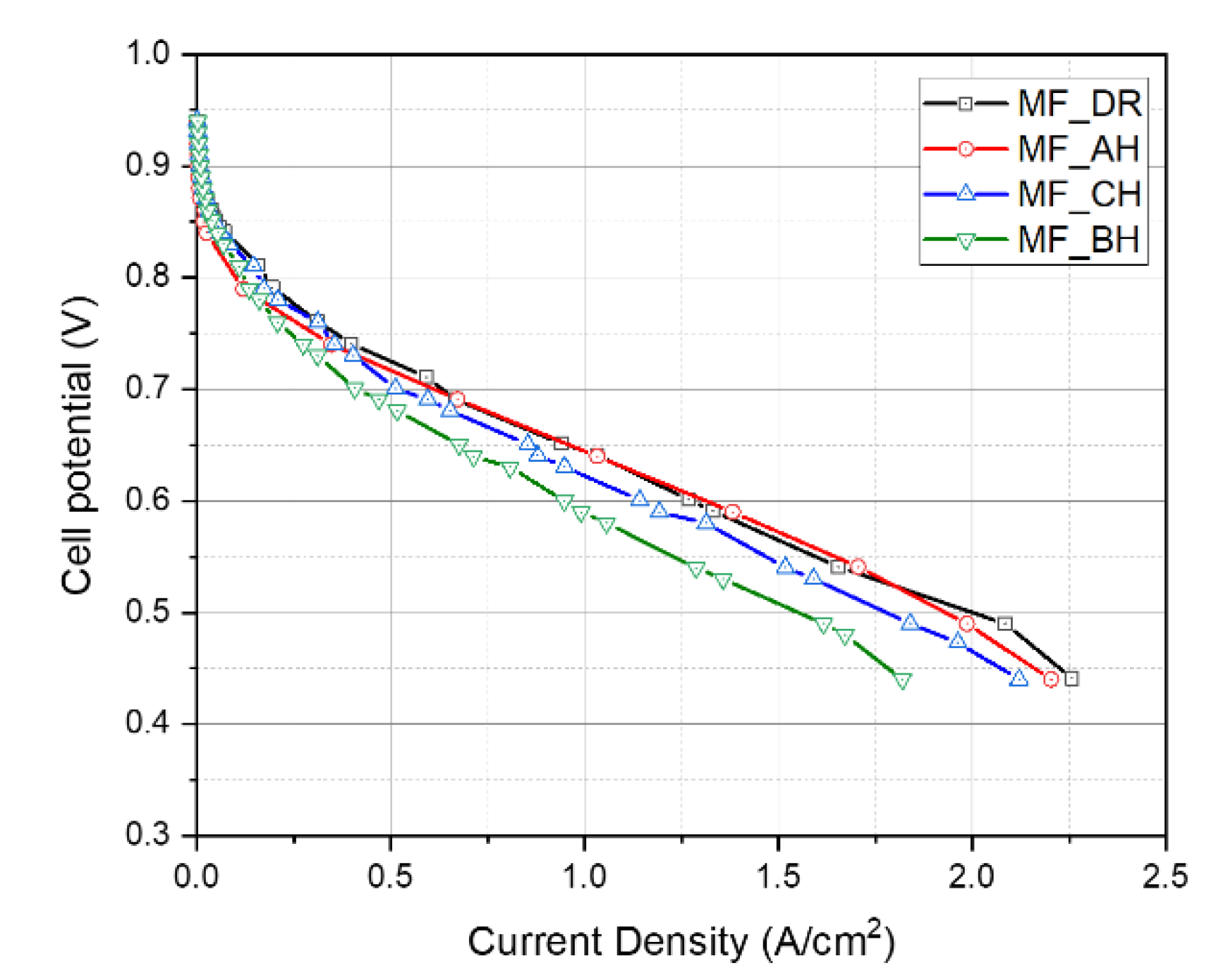
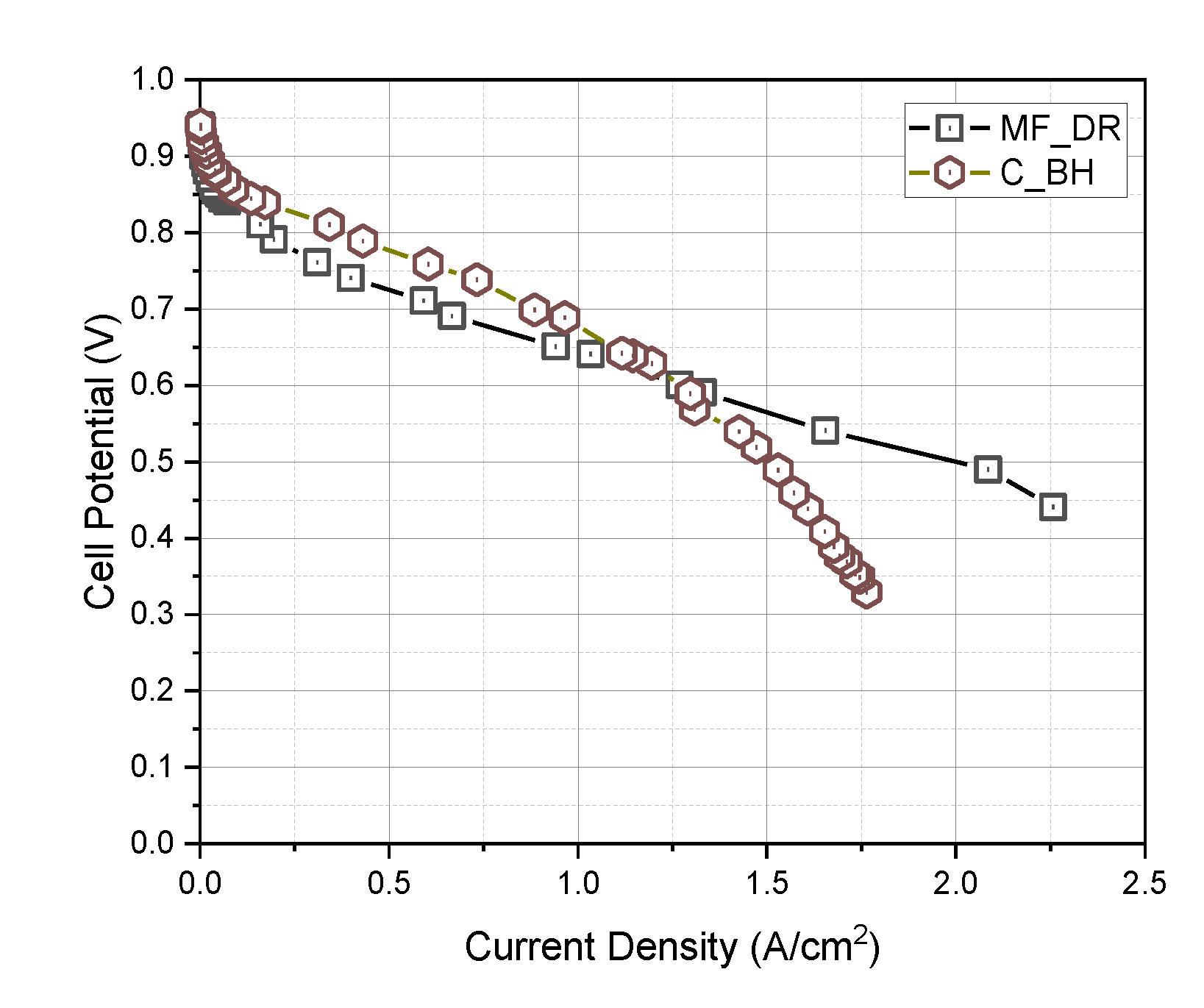
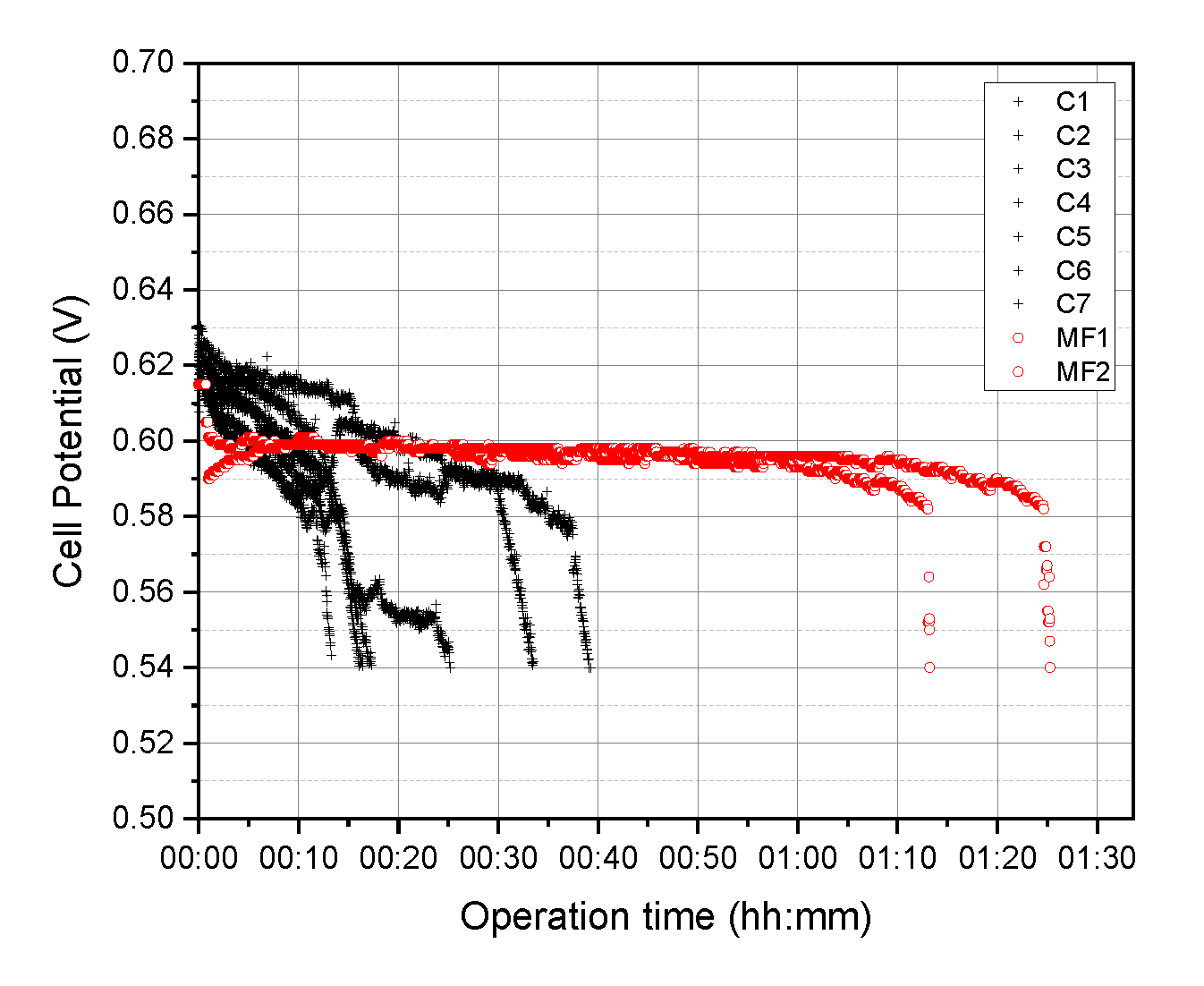
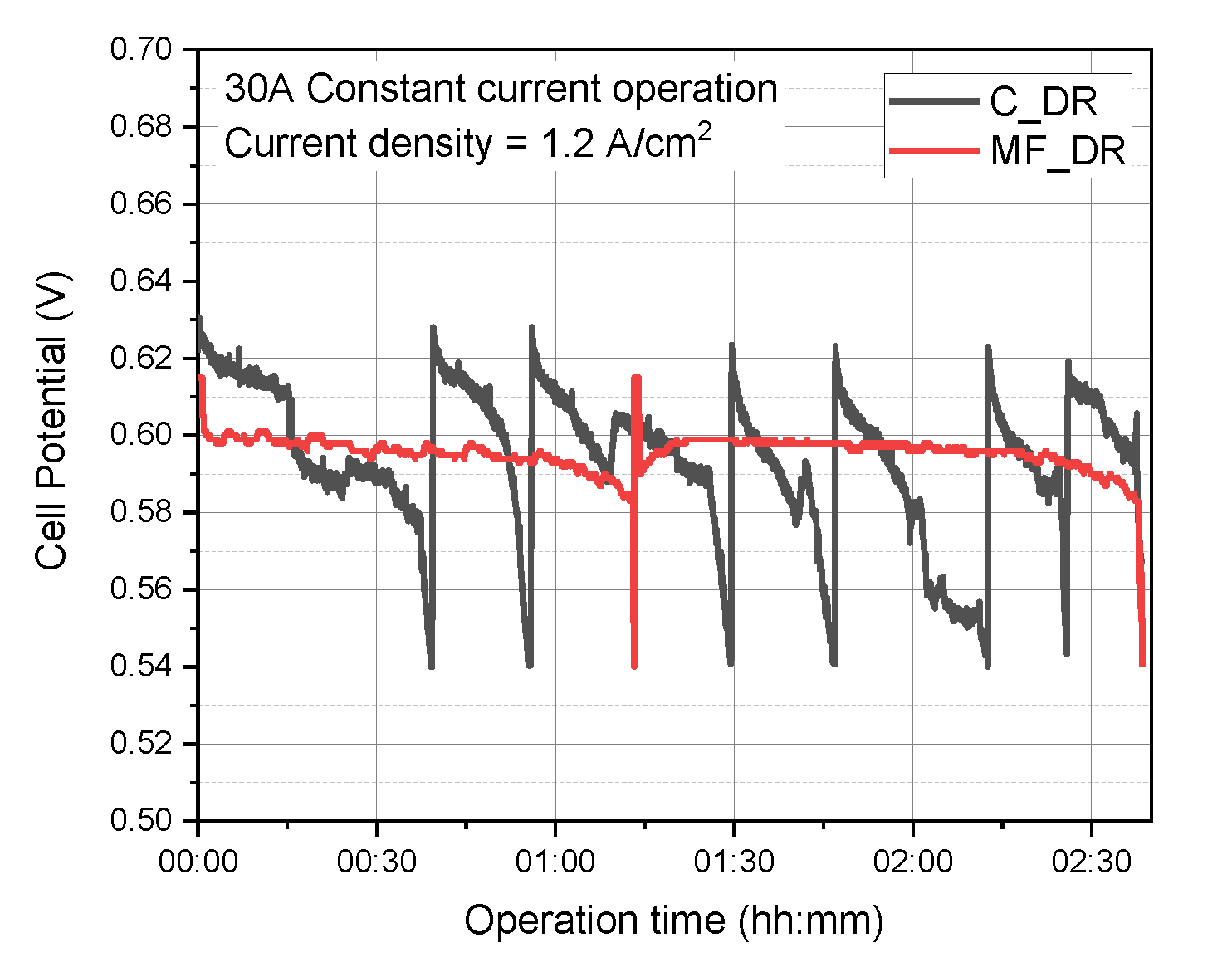

| Properties of Fuel Cell Configuration | |||
|---|---|---|---|
| 4-Channel Serpentine Flow Field | Metal Foam Type Flow Field | ||
| Active area | 25 cm2 | Active area | 25 cm2 |
| Width of channel | 1.0 mm | Thickness of metal foam (compressed) | 0.5 mm |
| Height of channel | 0.8 mm | Porosity of metal foam (compressed) | 76.79% |
| Width of rib | 1.0 mm | Hydrophobicity | Hydrophobic (contact angle = 95.8°) [48] |
| Operating Condition | |||
| Flow Through Operation Mode | Dead-Ended Operation Mode | ||
| Operating temperature | 60 °C | Operating temperature | 60 °C |
| Relative humidity (if necessary) | 100% | Current (CC mode) | 30 A |
| Stoichiometric ratio An/Ca | 1.2/2.5 | Fuel supply pressure | 0.5 bar |
© 2020 by the authors. Licensee MDPI, Basel, Switzerland. This article is an open access article distributed under the terms and conditions of the Creative Commons Attribution (CC BY) license (http://creativecommons.org/licenses/by/4.0/).
Share and Cite
Kim, M.-E.; Sohn, Y.-J. Study on Polymer Electrolyte Fuel Cells with Nonhumidification Using Metal Foam in Dead-Ended Operation. Energies 2020, 13, 1238. https://doi.org/10.3390/en13051238
Kim M-E, Sohn Y-J. Study on Polymer Electrolyte Fuel Cells with Nonhumidification Using Metal Foam in Dead-Ended Operation. Energies. 2020; 13(5):1238. https://doi.org/10.3390/en13051238
Chicago/Turabian StyleKim, Myo-Eun, and Young-Jun Sohn. 2020. "Study on Polymer Electrolyte Fuel Cells with Nonhumidification Using Metal Foam in Dead-Ended Operation" Energies 13, no. 5: 1238. https://doi.org/10.3390/en13051238
APA StyleKim, M.-E., & Sohn, Y.-J. (2020). Study on Polymer Electrolyte Fuel Cells with Nonhumidification Using Metal Foam in Dead-Ended Operation. Energies, 13(5), 1238. https://doi.org/10.3390/en13051238




